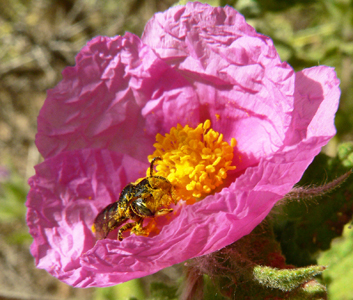A new study provides multiple lines of evidence on the total dependence of the solitary bee Flavipanurgus venustus (Andrenidae) on the flowers of a common Mediterranean scrub (Cistus crispus). This association was consistent across space (18 sites in SW Iberian Peninsula) and time (three years) despite the presence of other Cistus species whose flowers are morphologically similar. This finding is remarkable since bee specialization on a single flower species (monolecty) has been a questioned fact. Indeed, known cases have been explained by the absence of sympatric and synchronic flowers of the same plant genus or family, reflecting therefore a lack of closely related choices. The study uncovers that the bee's flight phenology is synchronized with the blooming period of C. crispus, and that the densities of bee populations are correlated with the local densities of this flower. This system provides new insights into the evolutionary ecology of extreme specialization in mutualistic interactions. Besides, it provides a nice example of the importance of interspecies interactions for biodiversity conservation. informacion[at]ebd.csic.es: González-Varo et al (2016) Total bee dependence on one flower species despite available congeners of similar floral shape. PLoS One http://dx.doi.org/10.1371/journal.pone.0163122
http://journals.plos.org/plosone/article?id=10.1371/journal.pone.0163122


 Las altas temperaturas están provocando que las lagunas y las marismas de Doñana pierdan agua rápidamente
Las altas temperaturas están provocando que las lagunas y las marismas de Doñana pierdan agua rápidamente




